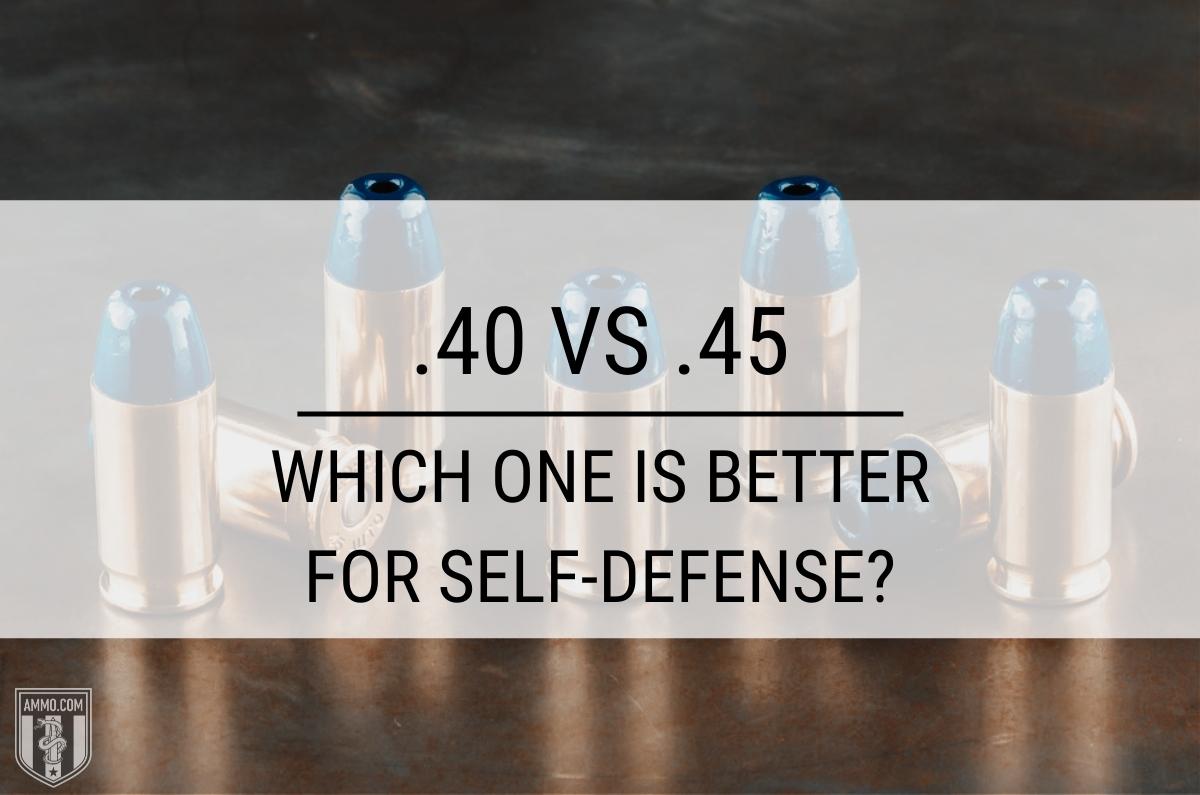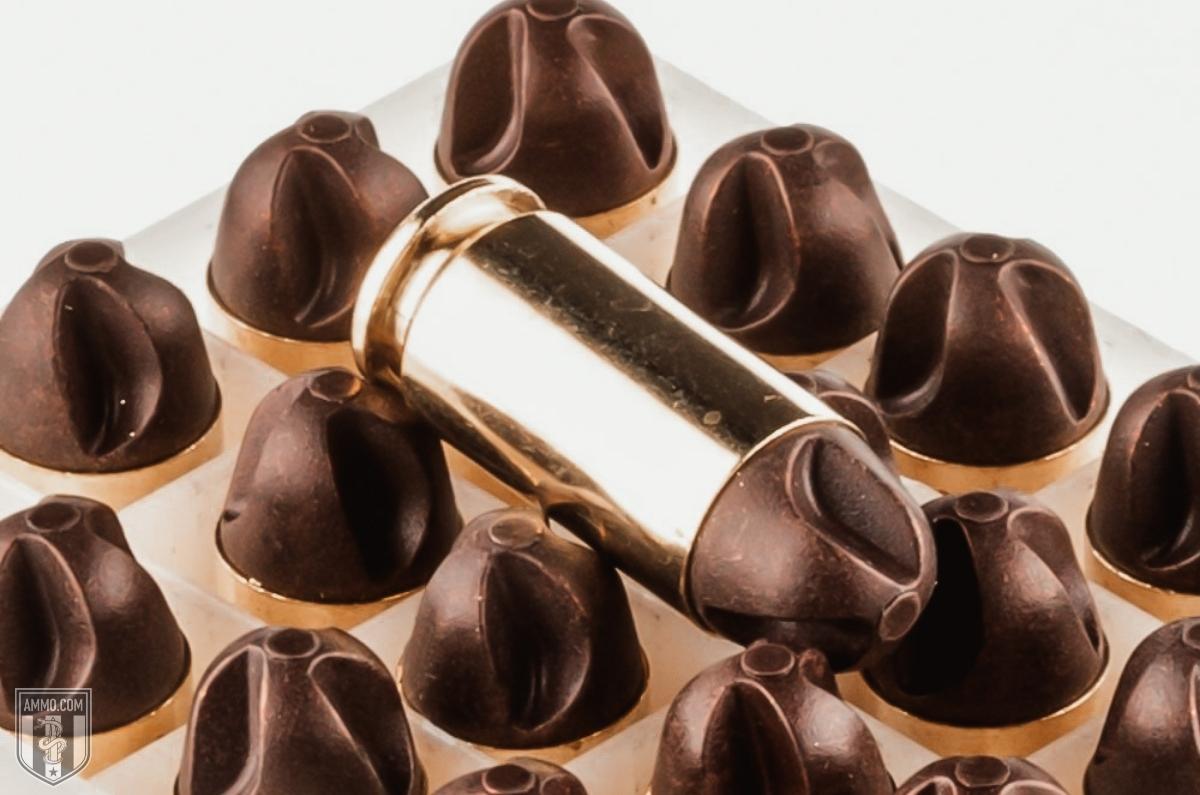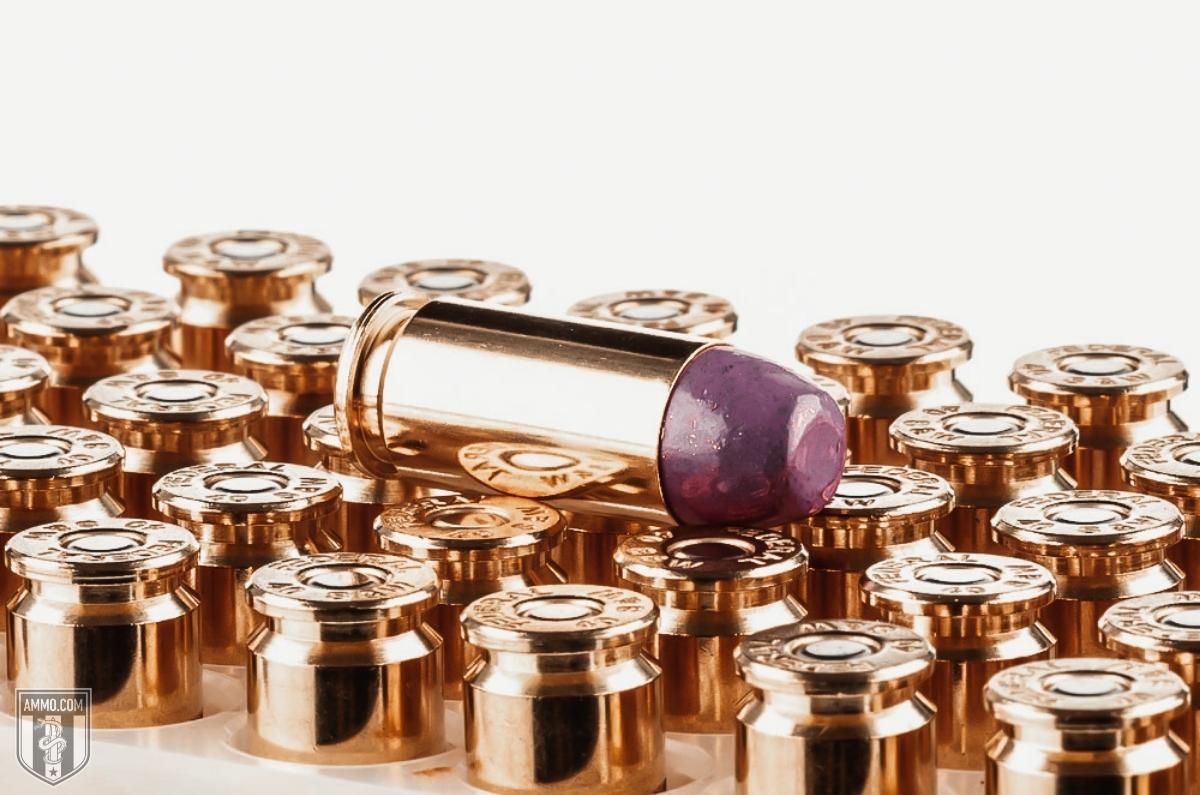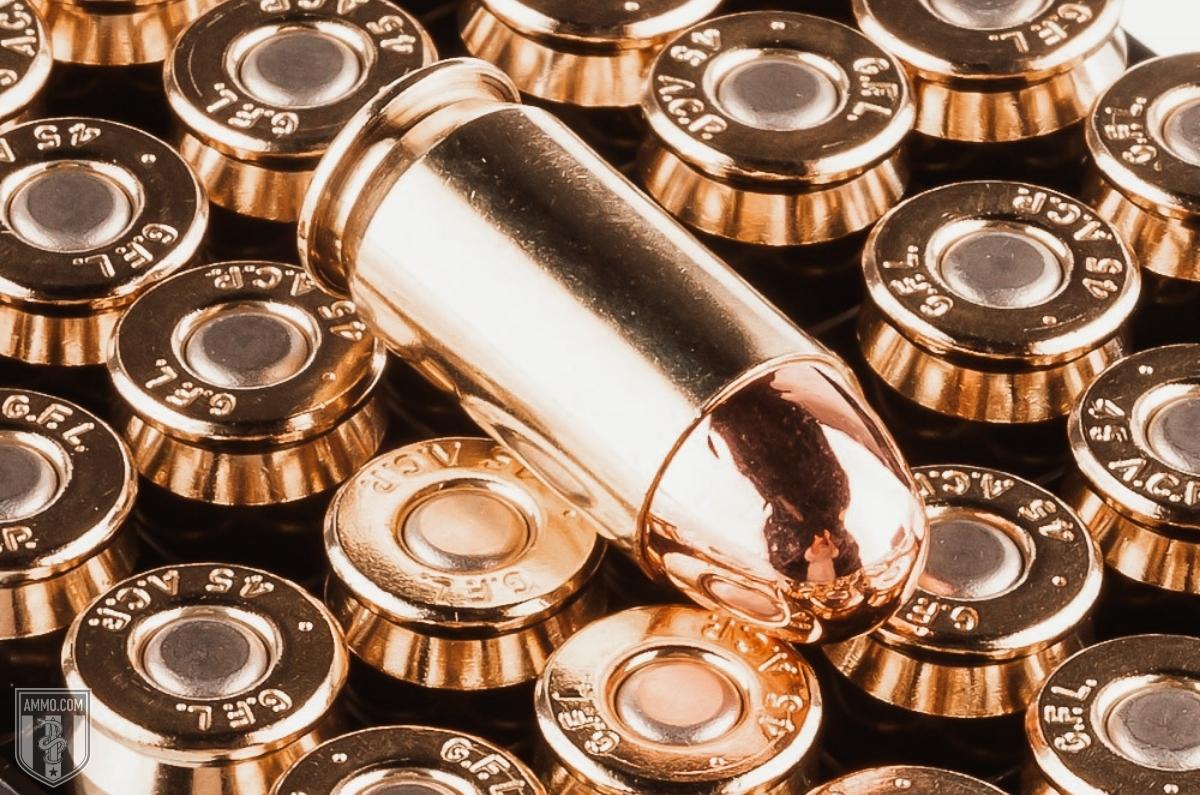By: Chris Dwulet | Ammo.com

When it comes to picking a handgun cartridge for your carry gun or for home defense, you can’t go wrong with the 40 Smith & Wesson (S&W) or the 45 ACP.
Both cartridges have faithfully served shooters for decades. The 45 ACP cut its teeth in the trenches of WWI and served the U.S. Military faithfully all the way through Vietnam. On the other hand, the 40 S&W was baptized by fire in the concrete jungle by law enforcement officers (LEO), the FBI, and CCW permit holders starting in the 90s all the way up to the present day.
However, many shooters find themselves in a dilemma when they decide to purchase a new semi-auto pistol: Which one is better? 40 S&W or 45 ACP?
In this article, we will take an unbiased look at each pistol cartridge and analyze all of the ballistics data, so you don’t have to! By doing so, when you waltz into your favorite local gun store to pick out your new self-defense handgun, you’ll know which one is going to best fit your needs.
What is the Difference Between a .40 and a .45? Let The Handgun Cartridge Debate Begin
The 45 ACP (Automatic Colt Pistol) is a rimless, centerfire, straight-walled pistol cartridge that was developed by John Moses Browning in 1904. After succeeding at military trials, it became the standard issue sidearm ammo for the Colt M1911 handgun. The 45 ACP fires 230-grain bullets at 830 feet per second (FPS) with 356 foot-pounds of muzzle energy per military standards.
The 40 S&W is a rimless, centerfire handgun cartridge that was developed in 1990 in a joint effort between Smith & Wesson and Winchester to satisfy the FBI’s needs for more effective defense rounds. The FBI initially adopted Lt Col. Jeff Cooper’s 10mm Auto for their new service cartridge but quickly discovered the recoil was too snappy for agents to handle. A reduced power load was developed that was the basis for the 40 S&W. Standard 40 S&W ammo fires a 165-grain bullet at 1130 FPS with 468 foot-pounds of muzzle energy.
Both cartridges are extremely popular for concealed carry, and with proper jacketed hollow point (JHP) ammo will have zero issues stopping a bad guy in a self-defense situation.
But are the 40 and 45 the right choice for you, or should you go with a 9mm Luger, 357 Magnum, 10mm Auto, or 357 SIG?
In the following sections, we will analyze the advantages and disadvantages of the 40 S&W and 45 ACP so you can answer that question.
Stopping Power
Since the dawn of concealed carry and the reliable semi-auto pistol, firearms gurus have been debating which caliber has the most “stopping power”. You’ll hear phrases thrown around like, “That 357 Magnum is a real man-stopper!” Or “I only carry 45 ACP because it has so much stopping power!” Insert your favorite cartridge into the previous phrases to keep the handgun caliber debate going.
The concept of stopping power has never been quantified and is often thought of as a round’s ability to stop a self-defense situation.
A personal defense engagement typically ends in one of two ways:
- The bad guy gives up
- Incapacitation by blood loss or by lacerating critical internal organs
A bullet’s ability to sap an opponent’s will to fight is highly subjective. And as life is not a game of D&D, we cannot go to the local enchantress to apply a modifier to our handgun ammo to leech Constitution (roll 2d20 for a critical hit).
If we are to believe that hitting an attacker hard enough will make them surrender, we can compare the muzzle energy of the 40 S&W and 45 ACP rounds.
Looking at the ballistics tables below, there is no significant kinetic energy difference between the 40 and 45. There are some loadings that perform better in certain terms, primarily those of the +P varieties, however, in general, the muzzle energy for either handgun round is around 400 foot-pounds of force.
The 40 S&W generally fires lighter bullets at a higher velocity while the 45 ACP is slinging a heavier bullet at a slower FPS.
So, if muzzle energy is a wash between the two rounds, then it comes down to the capacity to wound an attacker.
The simple truth is that the 45 ACP fires a wider bullet diameter than the 40 S&W (0.452” vs 0.40”, respectively). Wound channels produced by jacketed hollow point ammo are superior to full metal jacket (FMJ) ammo. This is because the JHP will expand upon contacting soft tissue and the FMJ will not. You should always carry quality JHP ammo in your personal defense handgun.

When a hollow point expands, you should expect it to increase its diameter by 90-100%. This means that, under ideal conditions, your 40 S&W will open up to 0.80” and 45 ACP to 0.90”. That’s not a huge difference, but it IS different.
Sometimes, one-tenth of an inch can make a difference between hitting a major organ and only causing peripheral damage.
And for that reason, I must give a slight edge in stopping power to the 45 ACP.
Recoil
When considering a handgun round for your carry gun, recoil is important to consider because it affects follow-up shots. The more felt recoil and muzzle flip there is, the longer it will take to get your sights back on target for another shot.
Every shooter would love to have a handgun cartridge that has the felt recoil of a 9mm Luger with the power of a 357 Magnum. Sadly, you can’t have your cake and eat it too when it comes to recoil.
Normally, you would expect the round that fires the heavier bullet to have more recoil, however, that is not the case for 40 vs 45.
Many shooters report the 45 ACP as having less recoil than the 40 S&W. This is because 45 ACP rounds typically fire at subsonic velocities (under 900 FPS) and have lower overall chamber pressure than the 40. This leads many fans of the 45 ACP rounds to describe the recoil as a push.
As the 40 S&W is simply a 10mm Auto-lite, the 40 has considerably higher chamber pressure and fires its 165 or 180-grain bullet at a much higher velocity than a 45. This combination creates what many shooters describe as an incredibly snappy and sharp felt recoil similar to a 357 SIG.
Considering recoil is extremely important if you plan to conceal carry a lightweight subcompact sidearm. Smaller handguns will absorb less recoil and therefore transfer more energy to the shooter’s wrists. For example, a shooter will experience less recoil when shooting a full-sized Glock 21 or Colt 1911 when compared to a subcompact Glock 30, Springfield XD-S, or Beretta Nano.
As the 45 ACP is loaded to a lower pressure, it gives it the edge in terms of having less recoil and allowing for faster follow-up shots.

Velocity/Penetration
The FBI did extensive ballistics gel testing after the 1986 Miami Shootout to evaluate handgun defense rounds. They determined that a self-defense cartridge should have reliable expansion with 12-18” of penetration to be considered effective.
And when it comes to penetration, you want to shoot the heaviest bullet weight with the highest FPS that can be handled. A heavier bullet traveling at a higher velocity will carry more kinetic energy and allow it to penetrate deeper.
In terms of the 40 S&W and 45 ACP, there is not a lot of difference in penetration between JHP ammo. However, the 40 will typically penetrate a little deeper due to its higher FPS than the 45.
When a hollow point expands, it prevents over-penetration and causes additional damage to the bad guy. Therefore you should NEVER carry FMJ ammo in your self-defense sidearm, because an FMJ will not expand and will likely exit the bad guy and potentially harm an innocent bystander or damage private property.
Quality jacketed hollow point ammo such as Winchester PDX-1, Federal HST, or Speer Gold Dots have been proven by law enforcement agencies across North America to provide excellent penetration and terminal ballistics.
One final thing to consider is that self-defense ammo is typically loaded a little hotter than FMJ practice ammo. This is to ensure that the hollow point has enough FPS to penetrate deep enough to stop a bad guy.
Ammo companies will often load practice ammo a little lighter as it saves them money and also makes for a more enjoyable shooting experience for the end user.
As such, you should always shoot at least 1 magazine of your defense rounds through your carry gun every time you go to the range. This way you are used to the increased recoil and FPS you’ll experience when shooting full power jacketed hollow point ammo.
And if you need excellent penetration and muzzle velocity, the 40 S&W will be the right choice for you.

Accuracy
Accuracy is a difficult category to quantify as it is mostly dependent on the shooter’s skill level and the shooting platform they are using.
Most shooters will report that they have better accuracy with a cartridge that has less felt recoil. That suggests the 45 ACP would be the better choice for accuracy. However, I know several LEOs that are nothing short of a surgeon with a 40.
A handgun cartridge with higher recoil will sometimes cause shooters to flinch, either out of surprise from the firing of the pistol or in anticipation of recoil. A flinch will throw rounds off target as the shooter will disturb the sights before the bullet leaves the barrel.
What it comes down to is practice and trigger control. A marksman with solid shooting fundamentals and trigger control will have no problem achieving exceptional accuracy with their sidearm and handgun cartridge of choice, regardless of recoil.

All things being equal, the 40 and 45 are very accurate cartridges and there should be little to no difference between them. However, many shooters report better accuracy with the 45 ACP, which is likely due to softer felt recoil.
Magazine Capacity
Law enforcement shooting reports indicate that sidearm accuracy suffers when officers are put under stress.
How bad does it get? The numbers would suggest accuracy is around 20-30%, which means most shots fired actually miss.
As such, you want to bring as many handgun rounds as you can to ensure you can stay in the fight longer.
As the 45 has a wider bullet diameter, it will take up more space in the magazine. For example, a standard Glock 21 magazine can hold 13 rounds of 45 while a Glock 22 magazine will hold 15 rounds of 40.
In terms of magazine capacity, the 40 is clearly the superior choice.

Concealed Carry/Home Defense
When it comes to home defense, my choice is the 45 ACP because I want a heavier bullet that can more likely stop an attacker or would-be home invader sooner, with as few shots as possible. The Winchester Ranger-T JHP would be my choice of ammo for this role.
For home defense, handgun weight is less important, and I would actually recommend a full-size semi-auto pistol as the added weight will reduce felt recoil. A Sig Sauer P220, Ruger SR1911, or Glock 21 would fill this role perfectly.
When it comes to concealed carry, handgun weight is a bigger issue.
Now some CCW permit holders will scoff at the weight and carry a full-size Springfield 1911 Range Officer all day long, and to that, I salute your commitment. However, it’s a lot more comfortable to conceal carry a subcompact polymer-framed handgun like a Glock 27 since it’s so much lighter.
When you’re out in the concrete jungle, the two main factors to consider in caliber selection are magazine capacity and penetration.
When you are out of your home, you are limited to the number of bullets you can carry on your person. Therefore, a higher magazine capacity is preferred when you concealed carry.
Furthermore, depending on the climate you live in, there is the possibility you will have to engage a threat through multiple levels of clothing. Fabrics, especially denim, are notorious for slowing down bullets and clogging hollow points, and decreasing their effectiveness by inhibiting expansion.
Taking all these points into consideration, the 40 makes more sense for CCW as it has a higher magazine capacity and will penetrate deeper than a 45.
Bottom line: 45 for home defense, 40 for concealed carry.

Ammo and Handgun Cost/Availability
The three most popular handgun calibers in North America are 9mm Luger, 40 S&W, and 45 ACP. As such, ammo for 40 and 45 is plentiful and diverse.
When it comes to cost, the 40 is the cheaper option at the time of writing. On average, practice ammo will run you around $0.50/round while FMJ 45 rounds will hit your wallet around $0.60/round.
Federal 40 S&W can range anywhere from $0.50/round to $1.50/round depending on your needs.
Premium self-defense ammo like Winchester Silvertip or Speer Gold Dot 40 S&W will put you in the area of $1/round, while a box of Federal 45 ACP HST will deliver pure stopping power at $2/round.
In terms of semi-auto handguns, the sky is the limit as there are numerous options for each caliber. As these are two of the most popular handgun cartridges, virtually every manufacturer has some offering for both. Ruger, Glock, Springfield, Kimber, Smith and Wesson, Taurus, CZ-USA, Beretta, and Sig Sauer all have multiple pistols in 40 and 45.
When it comes to cost the price between 40 and 45 is typically inconsequential when dealing within the same line. For example, a Springfield XD 40 will be about $20 less than an XD 45 (based on MSRP).
Buying in bulk is always smart, make sure to check out our stock of 45 ACP bulk ammo and bulk 40 S&W ammo.

Reloading
If you enjoy rolling your own handloads, then you’ll love the 45 and 40. There are a wide variety of powders and bullets to choose from to make your perfect practice ammo.
Reloading for both calibers is very simple and very rewarding at the same time.
If, however, you are reloading for an older model Glock 40 cal, please be aware of the “Glock bulge” that can cause a potential failure point in your brass cases.
Ballistics
Our team here at Ammo.com has spent countless hours haranguing ammo manufacturers for their ballistics data so you don’t have to!
Below are the ballistics tables for both 40 and 45, comparing bullet weight, muzzle velocity, muzzle energy, and trajectory for various loadings of each handgun cartridge.
.40 S&W Ballistics
Note: This information comes from the manufacturer and is for informational purposes only. The actual ballistics obtained with your firearm can vary considerably from the advertised ballistics. Also, ballistics can vary from lot to lot with the same brand and type load.
| 40 Cal (S&W) Bullet WEIGHT | Muzzle VELOCITY (fps) | Muzzle ENERGY (ft. lbs.) | Mid-Range TRAJECTORY (in.) | Barrel Length (in.) | |||||
|---|---|---|---|---|---|---|---|---|---|
| Muzzle | 50 yds. | 100 yds. | Muzzle | 50 yds. | 100 yds. | 50 yds. | 100 yds. | ||
| 120 Grain | 1150 | n/a | n/a | 352 | n/a | n/a | n/a | n/a | n/a |
| 125 Grain | 1265 | 1102 | 998 | 444 | 337 | 276 | -3 | n/a | 4″ |
| 135 Grain | 1140 | 1070 | n/a | 390 | 345 | n/a | 0.9 | n/a | 4″ |
| 135 Grain Guard Dog | 1200 | 1040 | 940 | 430 | 325 | 265 | n/a | n/a | 4″ |
| 155 Grain | 1140 | 1026 | 958 | 447 | 362 | 309 | 0.9 | 4.1 | 4″ |
| 155 Grain JHP | 1175 | n/a | n/a | 475 | n/a | n/a | n/a | n/a | n/a |
| 165 Grain FMJ | 1050 | n/a | n/a | 404 | n/a | n/a | n/a | n/a | n/a |
| 165 Grain JHP | 1100 | n/a | n/a | 443 | n/a | n/a | n/a | n/a | n/a |
| 165 Grain | 1150 | n/a | n/a | 485 | n/a | n/a | n/a | n/a | 4″ |
| 175 Grain | 1010 | 948 | 899 | 396 | 350 | 314 | n/a | n/a | 4″ |
| 180 Grain FMJ | 985 | 936 | 893 | 388 | 350 | 319 | 1.4 | 5 | 4″ |
| 180 Grain | 1000 | 943 | 896 | 400 | 355 | 321 | 4.52 | n/a | 4″ |
| 180 Grain | 1015 | 960 | 914 | 412 | 368 | 334 | 1.3 | 4.5 | 4″ |
| 155 Grain +P | 1300 | n/a | n/a | 582 | n/a | n/a | n/a | n/a | n/a |
| 180 Grain +P | 1100 | n/a | n/a | 484 | n/a | n/a | n/a | n/a | n/a |
.45 ACP Ballistics
Note: This information comes from the manufacturer and is for informational purposes only. The actual ballistics obtained with your firearm can vary considerably from the advertised ballistics. Also, ballistics can vary from lot to lot with the same brand and type load.
| 45 Auto (ACP) Bullet WEIGHT | Muzzle VELOCITY (fps) | Muzzle ENERGY (ft. lbs.) | Mid-Range TRAJECTORY (in.) | Barrel Length (in.) | |||||
|---|---|---|---|---|---|---|---|---|---|
| Muzzle | 50 yds. | 100 yds. | Muzzle | 50 yds. | 100 yds. | 50 yds. | 100 yds. | ||
| 150 Grain | 1050 | n/a | n/a | 403 | n/a | n/a | n/a | n/a | n/a |
| 165 Grain | 1030 | 930 | n/a | 385 | 315 | n/a | 1.2 | n/a | 5″ |
| 165 Grain Guard Dog | 1140 | 1030 | 950 | 475 | 390 | 335 | n/a | n/a | 5″ |
| 185 Grain | 1000 | 940 | 890 | 410 | 360 | 325 | 1.1 | 4.9 | 5″ |
| 185 Grain Match | 770 | 705 | 650 | 245 | 204 | 175 | 2 | 8.7 | 5″ |
| 200 Grain | 940 | 890 | 840 | 392 | 352 | 312 | 2 | 8.6 | 5″ |
| 200 Grain | 975 | 917 | 860 | 421 | 372 | 328 | 1.4 | 5 | 5″ |
| 230 Grain | 830 | 800 | 675 | 355 | 325 | 300 | 1.6 | 6.8 | 5″ |
| 230 Grain | 880 | 846 | 816 | 396 | 366 | 340 | 1.5 | 6.1 | 5″ |
| 165 Grain +P | 1250 | n/a | n/a | 573 | n/a | n/a | n/a | n/a | n/a |
| 185 Grain +P | 1140 | 1040 | 970 | 535 | 445 | 385 | 0.9 | 4 | 5″ |
| 200 Grain +P | 1055 | 982 | 925 | 494 | 428 | 380 | n/a | n/a | 5″ |
Final Shots: .40 vs .45
With so many law enforcement departments switching back to the 9mm Luger for their duty sidearm, many fans of the 40 and 45 are left wondering if their chosen caliber is obsolete. And the answer is, “Not in the slightest!”

The 40 Smith & Wesson offers exceptional penetration and punishing terminal ballistics that makes any would-be attacker wish they’d never gotten out of bed that morning. The 40 is a “jack of all trades, master of none” caliber that attempts to compromise between 9mm Luger and 45. It offers acceptable magazine capacity like a 9mm pistol and stopping power like a 45, but it does so at the cost of added pressure and higher felt recoil.
The 45 ACP is a tried-and-true warhorse that served the U.S. military from World War I to Vietnam. Although the 45 is a much lower pressure round compared to the 40, its heavier 230-grain weight bullets have stopped many a bad guy in their tracks with devastating effectiveness. As the primary chambering for the 1911 handgun, it is truly America’s Caliber and is beloved by historians, military personnel, LEOs, and civilians alike.
Which handgun cartridge is best for you is a deeply personal decision that each marksman needs to consider.
The 40 will generally require more training to use effectively due to its snappy recoil as many shooters will have difficulty handling the round.
The 45 offers a larger weight and diameter bullet with a softer recoil impulse at the cost of a lower magazine capacity.
No matter which one you choose, I can promise you will not be outgunned when you have a 40 or 45-carry gun. The most important thing is to get out to the range and make sure you are proficient with your chosen caliber so that when the moment of truth arrives, you are ready for any self-defense situation.


















